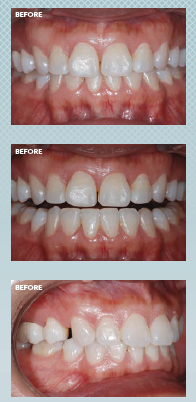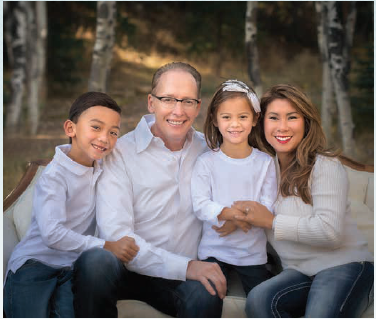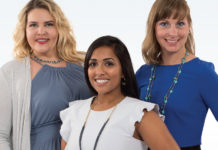
Lessons Learned From a Full Arch Reconstruction.
Not every dentist experiences what it feels like to be on the other side of the drill, but a few years ago, that’s exactly what happened to me. My journey to a full upper arch reconstruction wasn’t the result of a single diagnosis or experience, but rather the culmination and result of many years of dentistry.
Like many people, my dental issues started when I was young. My parents didn’t really teach me too much about oral hygiene, nor did we have a lot of resources to take care of our teeth. So when I visited the dentist at about nine or ten years of age, I had ten cavities—all in the posterior.
I remember the experience well. We waited and waited for the dental exam, and finally after sitting in the waiting room for about two hours, a team member took me back to the chair. During the exam, the dentist was rough and somewhat demeaning—even to such a young patient.
All in all, I was at the dental office for about four and a half hours during that visit. The overall experience was not pleasant. I remember thinking at the time, “I’m going to grow up and become a dentist. I know I can do better than this.”
That experience stayed in my memory as I graduated from high school and picked a major in college. I knew I wanted to be a healthcare provider, and dentistry was my first choice. I attended dental school at the University of the Pacific in San Francisco, CA. Since the time I graduated, the school has been renamed the Arthur A. Dugoni School of Dentistry, after an exemplary dentist and dean of the dental school.
Searching for Solutions
It was during dental school that I decided to have my old fillings replaced. My front teeth were starting to protrude and I wanted to fix that too. I went to an orthodontist, and as part of his treatment he extracted my premolars and put braces on my teeth.
After two years of wearing them, I finally got the braces off, but the gaps remained. They weren’t as visible as they were previously, but he was not able to close the gaps where the premolars were. After six months of living with the gaps, I opted for a second treatment of braces.
Nine months into my second stint in braces, they were removed and the doctor told me that my gaps were “as good as it gets.” But, not surprisingly, my teeth started to shift, and after about nine months the gaps were getting bigger and I noticed a diastema which I hadn’t had before. The gaps eventually started to affect the health of my gums because food became trapped in the spaces and caused issues.

![]()
In the meantime, my career was progressing and my personal life was moving forward too. After dental school, I started out as an associate dentist in a practice in Oregon. That dental group had three practices and about 10 to 15 dentists. It was a great experience, but it was limited in terms of practicing comprehensive dentistry. And I knew from the start that I wanted to practice dentistry comprehensively.
I did some research and found the Dr. Dick Barnes Group (DDBG). I called the group and arranged for an Over-the-Shoulder Full Arch course at the practice where I worked. They sent Dr. Jim Downs as the instructor, whom I had met eight months earlier in Vail, CO, at a laser symposium. He eventually became my husband. That course changed my life personally and professionally. It was great to find colleagues with a philosophy of helping patients understand their optimal needs and how to keep their teeth for a lifetime.
After taking the course I stayed with the Oregon practice for about a year. But the practice was entrenched in their way of practicing dentistry—and it was largely based on giving patients only the treatments that insurance would cover. Eventually, I realized that my approach to dentistry did not fit in with the approach at the practice, and I moved on.
I decided to move to Colorado, where I found an established practice that was for sale. Two doctors had been practicing dentistry for about 40 years and wanted to sell their practice and retire. It was a great opportunity, so I took over that practice, started practicing comprehensive dentistry, and within a year, my team and I had already out-produced the former owners.
During the two years that I owned this practice, Dr. Downs and I were married and I became pregnant with our first child, Trevor. When I was ready to go on maternity leave, Dr. Downs and I agreed that we should consolidate our practices, and we merged mine with his. In 2009, we changed the practice name to LêDowns Dentistry—which combined our last names. With the change, I moved my patients to his practice and donated all my old equipment to an American Indian healthcare nonprofit organization.

![]()
The Right Time
In 2013, Dr. Downs was scheduled to teach a Full Arch Reconstruction course at Arrowhead Dental Laboratory in Sandy, Utah. As part of the course, Dr. Downs preps and seats a full arch or full mouth reconstruction on a volunteer patient. After years of recommending full arch and full mouth reconstructions to my patients, I decided it was finally time for me to become the patient and get a full arch reconstruction myself.
I had worn my teeth down over the years, and my Shimbashi was about 15. By restoring just one arch, Dr. Downs could get my Shimbashi to a 16 or 16.5, which would be helpful. My natural teeth were fairly square—they had a measurement of about 10 vertical and 9.5 horizontal—which isn’t ideal either. An upper full arch reconstruction could correct these issues as well as close the gaps that had bothered me for years.
I had my teeth prepped in the summer of 2013, and soon afterwards I attended my cousin’s engagement party in California. I hadn’t told anyone about my new teeth, so when I saw my family members at the party, it was a surprise. My temporaries were so natural and beautiful, it took about five hours for anyone to pinpoint what was different. One of my cousins said, “Nickie, did you lose weight? Is your hair different?” Finally she said, “Did you do your teeth?” And I replied, “I sure did!“ She then exclaimed, “It looks beautiful!” And those were just my temps.
When I finally had my permanent restorations seated, they didn’t disappoint. I only wish that I had done the reconstruction sooner! Today, my patients constantly compliment me on my teeth. Just the other day a patient asked, “Those are veneers?” And I replied, “Yes they are!” Then the patient said, “I thought you were just naturally blessed with beautiful teeth!”

![]()
As a result of my new smile, my patients can see firsthand the possibilities of a restoration. It made a real difference in my practice. Doctors who need to get their teeth done should not postpone treatment because it helps patients understand what is possible with today’s dentistry. Before-and-after photos are powerful tools, but it’s even more powerful to show patients in person what a restored smile looks like.
What I Learned
I learned a lot about the procedure by being a patient. The experience reinforced the importance of preframing the patient in terms of expectations. For example, until I became the patient, I didn’t realize that the drill was so loud. Although I’ve had my teeth worked on before, I hadn’t been bothered by the noise of the drill until I had my full upper arch restored in one sitting.
Some hand pieces, such as high-speed turbines, have a loud, high-pitched sound. The electric hand pieces are quieter to the practitioner, but they are still loud for patients due to the teeth being so close to the inner ear.
Now, I preframe all my patients with expectations of the loud noise from the drill, and also of the odors that will emanate from the teeth during the process. For example, when the temporaries are removed, there is an off-putting smell, and it’s good to prepare patients so they don’t think something has gone wrong.
Now that I have experienced this treatment, my advice for other doctors is to get restorative treatment done if they need it. And if not, find a continuing education class that offers firsthand experience with this type of dentistry, like the Hands-On Clinical course with the DDBG. It’s one thing to read and learn about large-case dentistry, but it’s another thing to watch it performed and then to practice doing that type of dentistry yourself.

![]()
For me, being a patient only deepened my understanding of full arch restoration cases. Recently, Dr. Downs and I opened a second branch of our practice in Green Valley Ranch, CO. The new location has 11 operatories, and we’re growing our practice all the time. I’m happy to go to work each day and show my patients what’s possible with dentistry.
After having been a patient myself, I not only have a deeper empathy for not only what my patients go through during the treatment, but also a greater understanding of what is possible for their lives after the treatment is complete. It has made a big difference in my life, and I know it can do the same for them.









